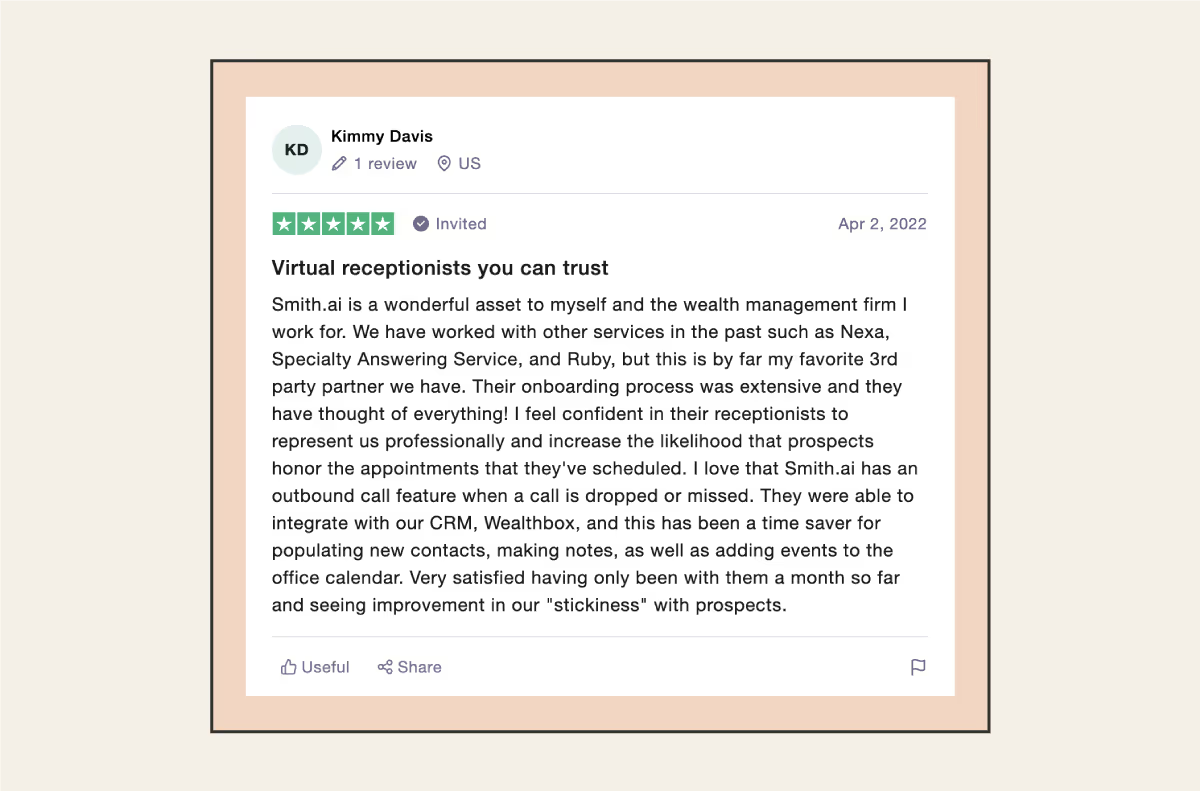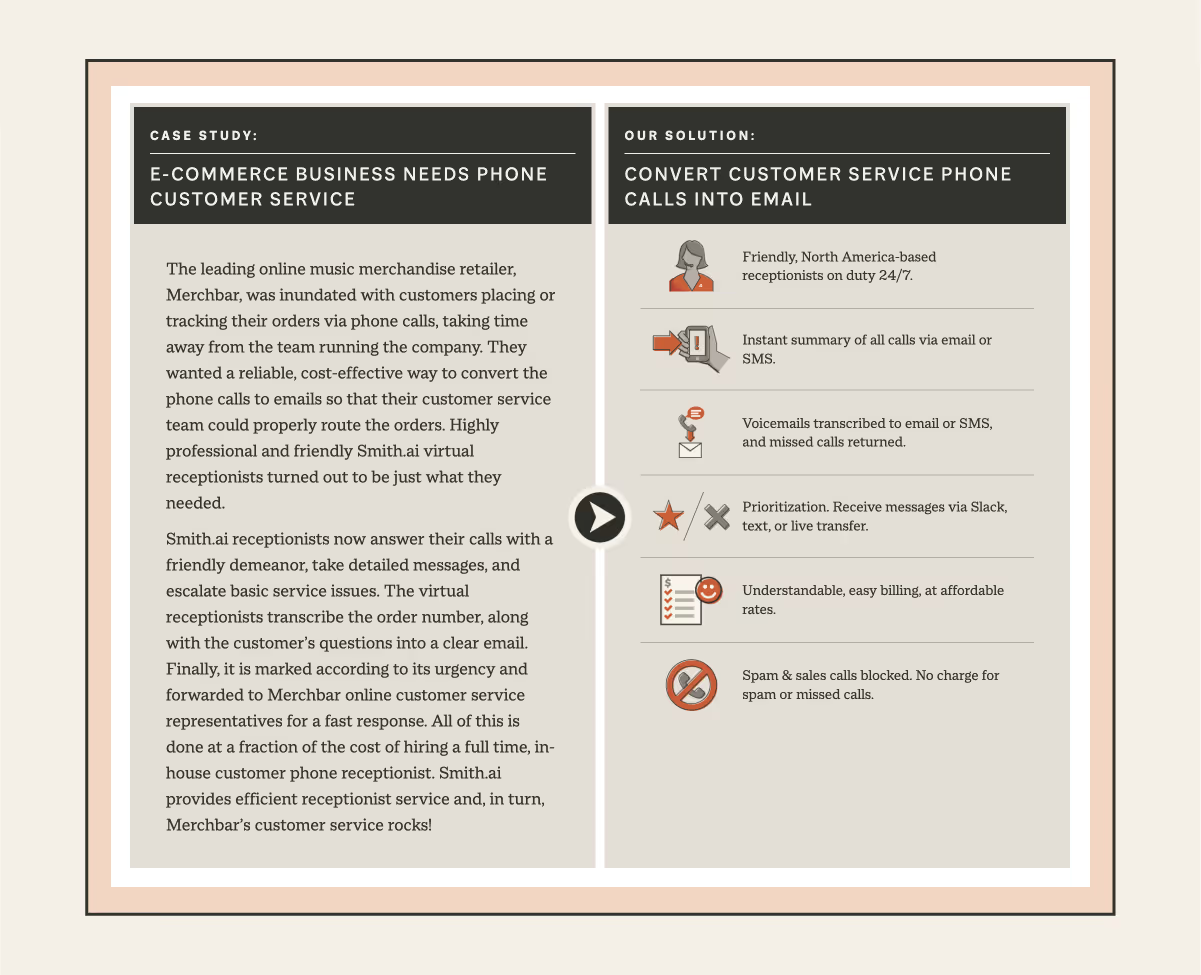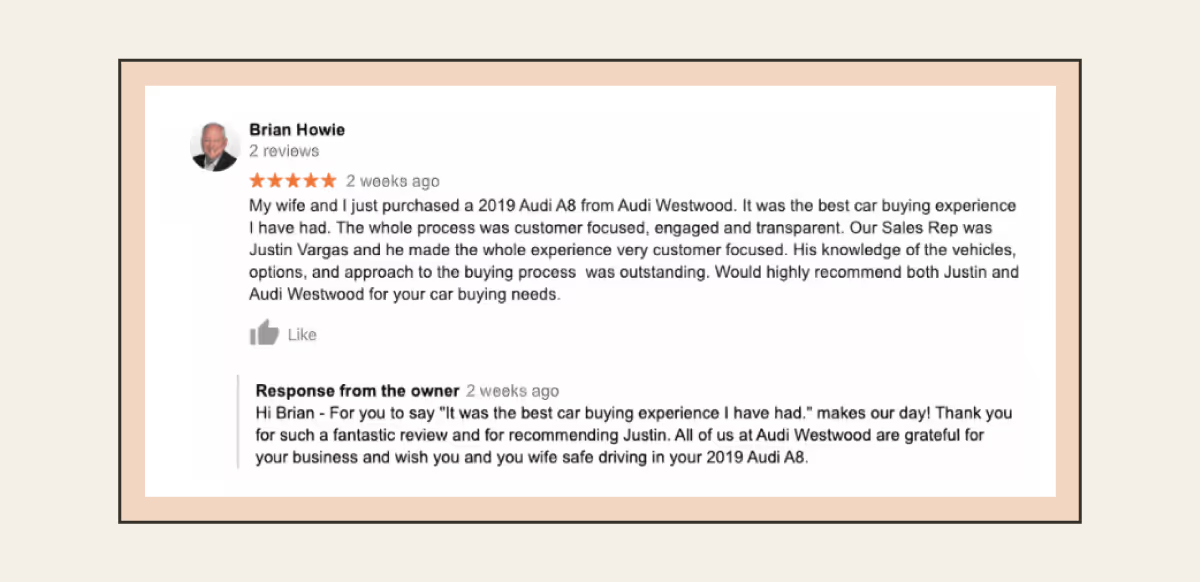How to Ask & Get Good Customer Reviews (+6 Templates)
How to Ask & Get Good Customer Reviews (+6 Templates)

Good customer reviews are imperative to any business. Research shows that 90% of customers read reviews before working with a business, and just 50 positive reviews translate to a 4.6% increase in conversions. So how do you get your clients to leave a good review?
Rated Excellent on TrustPilot, Smith.ai knows how powerful reviews have been to our growth, and we want the same for your business, so we’ve put together this guide on how to ask for and get good reviews.
Our guide will cover the different types of reviews, what makes a well-written review, how to request a review, and how to respond to reviews. Already an expert in all things reviews? Skip to our editable templates for requesting reviews and responding to them below.
6 Types of Reviews
Most people probably think of the star-scale review, but there are a lot more options out there thanks to the internet. Your company should be present where your customers are, so don’t be afraid to prioritize what’s most important in your industry, but make sure reviews are easy for your customers to find and create.
There are two main categories of reviews: first-party reviews and third-party reviews. First-party reviews are those collected and shared by the business itself, while third-party reviews are written and shared without any input from the business.

1. Quotes
Popular on business websites, you’ll often see a sentence or two in callout boxes, possibly with a picture of the person who said them.
Of all the types of reviews, these are probably the easiest to get. If you receive an email from a happy client, see moments of praise within a larger email, or get a glowing mention on social media, ask the person who wrote it if they’d be okay with you sharing the quote on your website. Most of the time, they’ll say yes.

2. Third-Party Sites
These reviews are written entirely by the client on a third-party website like Yelp, Google, or the Better Business Bureau. Potential clients view these as highly authentic (especially for local businesses) since the business has no control over whether the review gets published.
You’ll want to respond quickly to these reviews to show potential clients you are engaged and serious about improving your business.

3. Social Media
Social media reviews can happen organically or you can solicit them. Regardless of how they happen, clients value these as authentic reactions of real clients. Facebook has actually become one of the top review sites.
Just like on third-party sites, you’ll want to respond quickly to these reviews.

4. Case Studies
Unlike the other reviews listed so far, your business writes these, though they may include quotes and other information from clients. Use case studies to showcase how you helped your client reach their specific goals.
These are a great review resource for B2B companies as they can be used by stakeholders to guide their decision-making process before signing up for your service.
5. Customer Stories
Like case studies, you write customer stories, but instead of focusing on your work, make your client the focus. Send them a questionnaire or record an interview in which they talk about their experience with your business, then post those stories on your website.
Not only do these showcase real stories from your clients, but they also allow you to build personal connections with them and impress with great customer service, the first step to earning a good review.
6. User-Generated Content and Brand Ambassadors
It seems everyone has an internet following these days, so take advantage of it by encouraging your clients to share their experiences in whatever way they are most comfortable.
Add social media snippets or video reels to your website so user-generated content automatically appears for potential clients to see. Reach out to influencers and offer to give them a free trial in exchange for a review video or a long-form blog post. Then share those on your own social media channels.
What makes a well-written customer review
Whether the client gives you a rave review or a pan, every well-written customer review has the same key qualities.
Your clients may not know how to write a quality review, so you may want to include a link to a great customer review they can use as a guide while writing. Don’t let a client use “I didn’t know how to write a review” as an excuse for not writing one!
Honest and specific details
A five-star review (and even a one-star review) is meaningless if details are missing. Well-written reviews mention specific aspects of the experience that went well to build credibility with potential clients, and include specific details about what could be improved so you know how to make it better.
That being said, quality customer reviews don’t include contact information like personal phone numbers or email addresses. It also doesn’t need to be wordy as long as it explains the reasons behind the rating the client gave.

In the positive review example above, Peggy tells the reader exactly when her organization started working with usi. She explains their problem and gives specific ways we helped solve the problem for them. She mentions the onboarding experience and the little things we do that set us apart, and touches on cost, a key potential client consideration.
Useful and constructive feedback in a civil tone
No matter how glowing or terrible the review, it must have a civil or friendly tone. A well-written negative review will refrain from name-calling nd other pettiness so the business owner can respond with a plan to make it right. That same reviewer should be able to return to the business, have a better experience, and update their review to reflect their new experience.

Notice how the reviewer doesn’t rant about how this is the greasiest pizza crust they’ve ever eaten or abuse those who rave about the restaurant. Instead, they outline their experience tactfully.
Credibility
While no one is going to get out a red pen and start docking points for a misspelled word, well-written customer reviews are relatively free from errors. Not only does this add credibility to the review itself, but it also makes it easier for the business owner to understand the reviewer’s ideas.
3 steps to a five-star review
Fortunately, getting a five-star customer review isn’t that hard, especially if you already excel at the first step, providing stellar customer service. Once you have a system in place for steps two and three, getting a review should be a painless process, especially if you let your marketing automation shoulder some of the burden.
Step 1: Provide stellar customer service
It doesn’t matter what we say in the rest of this guide if you don’t take the biggest and most important step of the customer review process: providing stellar customer service.
Many business owners are afraid to ask for reviews because they worry about what people will say. But reviews are relatively in your control, as long as you make going above and beyond for your clients part of your day-to-day operations.
A great strategy to encourage stellar customer service is to make sure every phone call and chat query is answered quickly and appropriately. Virtual receptionists and live chat streamline the time it takes clients to get the answers they want, making them more likely to give your business a positive review.
Step 2: Ask for the review
While asking may feel uncomfortable, the fact is that 76% of people asked to leave a review will do so. Eventually, you’ll become more comfortable asking, and as you learn more about your clients and their buyer’s journey, you’ll have a better understanding of how to ask for a review.
Most importantly, use a strategy that you can scale as your business grows. Marketing automation software can shoulder a lot of the burden of asking for reviews through email, text message, and social media.
Who to ask for a review
On average, people who have a poor customer service experience are likely to tell 15 people, while those who have a positive experience are only likely to tell 11. In other words, someone who had a negative experience doesn’t need to be told to write a review; they’re going to do it anyway.
So if you want someone who had a positive experience to leave a review, you’ll probably need to ask them to, so empower your sales and customer service teams to also ask anyone who seems satisfied or happy with their experience to leave a review.
Don’t forget to ask your vendors and other partners for reviews, too! In fact, you may want to be proactive and leave a review for them first so they’ll be more likely to respond in kind to you.
When to ask for a review
There’s no definite answer about the best time to ask for a review, as that varies by industry. Instead, look for opportunities where asking for a review can come up naturally.
Examples of when to ask for a review include whenever a client:
- Makes a purchase
- Experiences success
- Re-purchases or renews
- Tags your business on social media
- Browses other products
- Gives a referral
- Interacts with customer service
Keep in mind that potential clients want to see multiple, recent reviews, so you’ll want to diversify when you ask clients for reviews.
How to ask for a good review
As we mentioned earlier, there are a lot of places where clients can leave reviews. How you ask for each type may vary slightly, but there are a few basic principles you’ll want to keep in mind.
- Keep it short. Over 23% of emails are skimmed rather than read, so keep your requests brief, even in emails.
- Explain why you are asking for the review. Offer a quick explanation for why reviews are important.
- Say thank you. Show your client you appreciate the time they took to write a quick review for you.
- Make it easy. Some clients may not know how to leave a good review. Provide links to multiple platforms where they can leave their review. Ask an open-ended question or provide a specific prompt to get them thinking. Take it a step further by including an example or a template for those who haven’t written a review before
- Explain how long it will take. Giving the client a specific (and short!) time frame makes it more likely they will knock it out now rather than wait until later and probably forget.
- Show them you read reviews. If the client sees you responding to reviews, whether they’re good or bad, they will feel that you value them as a client.
Remember to use a variety of request methods to meet your clients where they are and increase the chance of getting a review. You can use our editable email templates to help you craft the perfect request!

What not to do
Regardless of how you go about soliciting reviews, there are a few things you’ll want to avoid.
- Never offer an incentive in exchange for a review. This practice is strictly prohibited on third-party review sites and may result in your reviews being removed. You can, however, opt to do one of the following:
- Offer to donate money to a charity you support if the client submits a review
- Send an email asking for reviews and include a gift card or discount code for everyone regardless of whether or not they write a review
- Never purchase a review. It destroys the credibility of your existing reviews, and if future clients find out, they may choose not to do business with you.
- Never ask apologetically. When you start a request with “I hate to ask, but…” it decreases the chances the client will continue reading. Explain the importance of reviews to your business, and most people will be willing to write a few sentences about their experience. In fact, by asking for a review, you are showing them you value them and want to give them a voice in your business.
- Never push someone to write a review. You’ll come off as pushy and insincere to your client, which may mean a negative review or make them feel uncomfortable doing business with you in the future.
Step 3: Respond to reviews (yes, all of them)
Responding to all of your reviews shows clients that you engage with them and value their input. It elevates the credibility of the reviews themselves, of you as the business owner, and your business as a whole.
While you don’t need to refresh your review pages every minute so you can instantly respond, you should make checking for reviews a daily habit. Ideally, you want to respond to any review within a day, especially in the case of a negative review.
Always refer to the reviewer by name and thank them. Make your response as personal as possible so the writer knows you aren’t a computer with a canned response.
How to respond to a positive review
Writing a response to a positive review is a chance to use your brand’s personality authentically. Feel free to use a little humor or wit if that matches your brand.
Mirror the positives they mention, and if they name a specific person who impressed them, let them know you will pass their compliment along.
If you can without seeming too sales-y, ffer a recommendation. For example, if they recently purchased your software, recommend a blog post they should check out to better understand how it works.
Finally, ask if they would be okay with you sharing the review on social media.
Here is a positive review response example to get you started:

Your response to reviews don’t need to be long. Use the reviewer’s name in your response, and include something specific to the client to personalize the response.

Check out our editable positive review response templates!

How to respond to a negative review
Responding to negative reviews is a bit trickier. Your first impulse may be to respond with denial, especially if the tone of the review is brusque. Instead, take a deep breath and then dig in to what the reviewer is trying to say.
Once you’ve identified their frustration, apologize for what happened and be empathetic. Then attempt to resolve the situation. If there’s nothing you can do to solve the problem, tell them how you will make sure the problem won’t occur again.
If you need more details in order to make it right for the client, ask them to contact you privately.
Most importantly, follow through on whatever you discuss, and leave the review up. Don’t be surprised if the reviewer edits or responds to their original review to reflect the customer service they received after the review was posted.

In the above review, Jur apologized, explained why the issue occurred, and identified the change they are making to prevent the issue from happening again.
We know responding to negative reviews can be tricky, so use our editable negative review response templates to help.

If you’ve done the hardest part and provided exceptional customer service, asking your client to leave a good review shouldn’t be difficult, especially if you’ve automated the task. Just remember to be confident, explain why you're asking, and make it quick and easy for the client to do. After the review is posted, respond to the review so your clients know you are engaged in the process.
If you’re looking to improve your customer experience so you can get better reviews, Smith.ai can help. Our virtual receptionists, live chat service, and outbound campaigns are able to seamlessly integrate with your existing marketing sales stack. Book a call today to see how we can help your business on the path to asking for and getting good customer reviews.
Sources: Invesp | BigCommerce | BrightLocal | Help Scout | Sender
Take the faster path to growth. Get Smith.ai today.
Key Areas to Explore
Technical Implementation Terms
Voice user interface (VUl) design
Speech recognition integration
Text-to-speech optimization
API connectivity and webhooks
Real-time data synchronization

Your submission has been received!














.svg)



